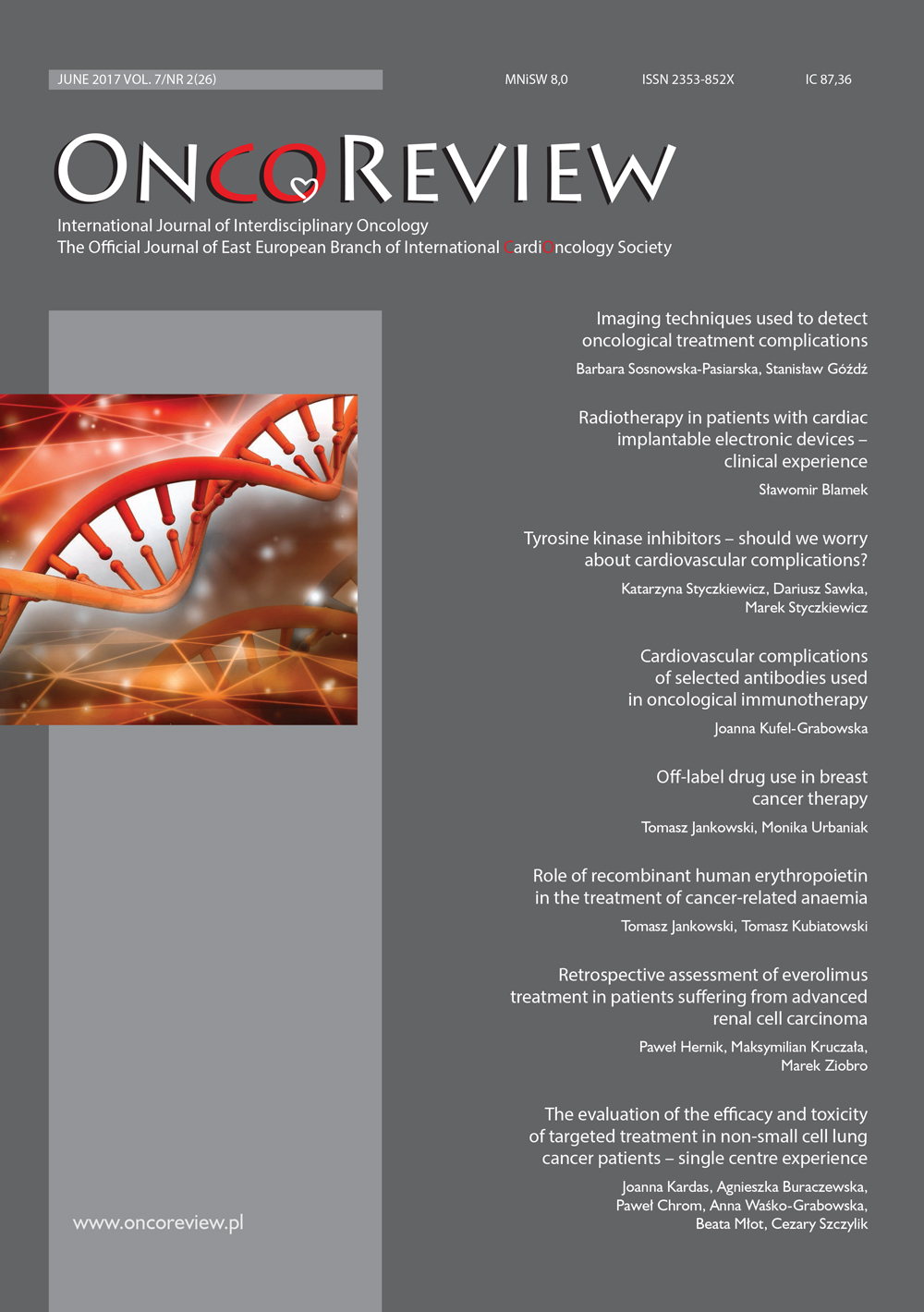Imaging techniques used to detect oncological treatment complications Review article
Main Article Content
Abstract
Oncological drugs are toxic for the cardiovascular system, directly affecting cardiac function and anatomy. Oncological treatment complications may thus take the form of asymptomatic myocardial dysfunction, overt heart failure, exacerbation of the symptoms of ischaemic heart disease, thromboembolic complications, arterial and pulmonary hypertension, pericardial complications, valvular disease and arrhythmia. Presently, we have a number of diagnostic tools at our disposal to detect cardiotoxicity, and the choice of one imaging technique over the others depends on the availability of that particular diagnostic method, and on its ability to provide optimum visualization. The basic method for cardiac assessment in oncological patients is transthoracic echocardiography (TTE). It is a widely available method which enables assessment of cardiac structures and haemodynamics without exposing the patient to an additional dose of ionizing radiation. In the case of poor TTE visualization, a recommended method for the assessment of cardiac function and structures is magnetic resonance. Chest, heart and coronary artery CT is also very useful in the diagnostics of oncological treatment complications. Moreover, cardiotoxicity diagnostics also involves nuclear medicine imaging techniques, including gated radionuclide ventriculography, whose advantage is high repeatability, with the disadvantage being the patient’s exposure to ionizing radiation and limited information on the structure and function of the myocardium. Both ECG-gated single photon emission computed tomography (SPECT) and positron emission tomography (PET) deliver information on the global and regional function of the left ventricle, presence of intraventricular synchrony, and myocardial perfusion. Early detection of subclinical dysfunction of the left ventricular myocardium in patients treated with potentially cardiotoxic drugs is well-grounded and aimed at the prevention of cardiovascular mortality by means of a primary prevention strategy.
Downloads
Metrics
Article Details

This work is licensed under a Creative Commons Attribution-NonCommercial 4.0 International License.
Copyright: © Medical Education sp. z o.o. This is an Open Access article distributed under the terms of the Attribution-NonCommercial 4.0 International (CC BY-NC 4.0). License (https://creativecommons.org/licenses/by-nc/4.0/), allowing third parties to copy and redistribute the material in any medium or format and to remix, transform, and build upon the material, provided the original work is properly cited and states its license.
Address reprint requests to: Medical Education, Marcin Kuźma (marcin.kuzma@mededu.pl)
References
2. Lang RM, Badano LP, Mor-Avi V et al. Recommendations for Cardiac Chamber Quantification by Echocardiography in Adults: An Update from the American Society of Echocardiography and the European Association of Cardiovascular Imaging. J Am Soc Echocardiogr 2015; 28: 1-39.
3. Voigt JU, Pedrizzetti G, Lysyansky P et al. Definitions for a common standard for 2D speckle tracking echocardiography: consensus document of the EACVI/ASE/Industry Task Force to standardize deformation imaging. Eur Heart J Cardiovasc Imaging 2015; 16: 1-11. https://doi.org/10.1093/ehjci/jeu184.
4. Sawaya H, Sebag IA, Plana JC et al. Early detection and prediction of cardiotoxicity in chemotherapy-treated patients. Am J Cardiol 2011; 107(9): 1375-1380. https://doi.org/10.1016/j.amjcard.2011.01.006.
5. Negishi K, Negishi T, Hare JL et al. Independent and incremental value of deformation indices for prediction of trastuzumab-induced cardiotoxicity. J Am Soc Echocardiogr 2013; 26(5): 493-498.
6. Thavendiranathan P, Poulin F, Lim KD et al. Use of myocardial strain imaging by echocardiography for the early detection of cardiotoxicity in patients during and after cancer chemotherapy: a systematic review. J Am Coll Cardiol 2014; 63(25 Pt A): 2751-2768.
7. Mousavi N, Tan TC, Ali M et al. Echocardiographic parameters of left ventricular size and function as predictors of symptomatic heart failure in patients with a left ventricular ejection fraction of 50-59% treated with anthracyclines. Eur Heart J Cardiovasc Imaging 2015; 16(9): 977-984.
8. Tariq H, Amin S, Singh M et al. Predicting heart attack in a patient post-radiation therapy using plaque CCTA analysis and serum biomarker test. Case report. OncoReview 2014; 4: 54-61.
9. Ganz WI, Sridhar KS, Ganz SS et al. Review of tests for monitoring doxorubicin-induced cardiomyopathy. Oncology 1996; 53: 461-470.
10. Altena R, Perik PJ, van Veldhuisen DJ et al. Cardiovascular toxicity caused by cancer treatment: strategies for early detection. Lancet Oncol 2009; 10: 391-399.
11. Bellenger NG, Burgess MI, Ray SG et al. Comparison of left ventricular ejection fraction and volumes in heart failure by echocardiography, radionuclide ventriculography and cardiovascular magnetic resonance; are they interchangeable? Eur Heart J 2000; 21: 1387-1396.
12. Amalia Peixb A, Mesquitac CT, Paeza D et al. Nuclear medicine in the management of patients with heart failure: guidance from an expert panel of the International Atomic Energy Agency (IAEA). Nucl Med Commun 2014; 35: 818-823.
13. Nakata T, Wakabayashi T, Kyuma M et al. Prognostic implications of an initial loss of cardiac metaiodobenzylguanidine uptake and diabetes mellitus in patients with left ventricular dysfunction. J Card Fail 2003; 9: 113-121. https://doi.org/10.1054/jcaf.2003.14.
14. Merlet P, Benvenuti C, Moyse D et al. Prognostic value of MIBG imaging in idiopathic dilated cardiomyopathy. J Nucl Med 1999; 40: 917-923.
15. Ness KK, Armstrong GT. Screening for cardiac autonomic dysfunction among Hodgkin lymphoma survivors treated with thoracic radiation. J Am Coll Cardiol 2015; 65: 584-585.
16. Kim J, Park KS, Jeong GC et al. Routine oncologic FDG PET/CT may be useful for evaluation of cancer therapy induced cardiotoxicity. J Nucl Med 2014; 55 (suppl 1): 1549.
17. Vilardi I, Zangheri B, Calabrese L et al. Chemotherapy effect on FDG myocardial uptake. J Nucl Med 2011; 52: 115.
18. Fiechter M, Ghadri J, Gebhard C et al. Adding CFR improves diagnostic accuracy of 13N-ammonia PET MPI to detect CAD. J Nucl Med 2012; 53: 86.
19. Aggarwal NR, Drozdova A, Wells Askew J et al. Feasibility and diagnostic accuracy of exercise treadmill nitrogen-13 ammonia PET myocardial perfusion imaging of obese patients. J Nucl Cardiol 2015; 22: 1273-1280. https://doi.org/10.1007/s12350-015-0073-z.
20. Lau J, Laforest R, Zheng J et al. 13N-Ammonia PET/MR myocardial stress perfusion imaging early experience. J Nucl Med 2014; 55: 242.
21. Song J, Yan R, Wu Z et al. 13N-ammonia PET/CT detection of myocardial perfusion abnormalities in Beagle dogs after local heart irradiation. J Nucl Med 2017; 58(4): 605-610. https://doi.org/10.2967/jnumed.116.179697.

